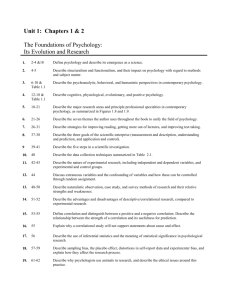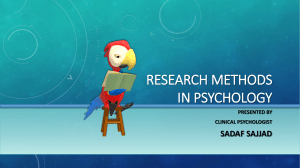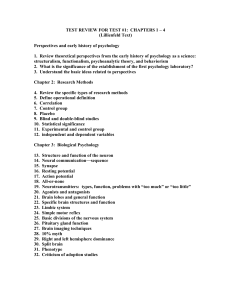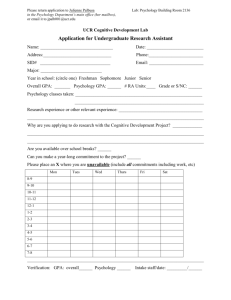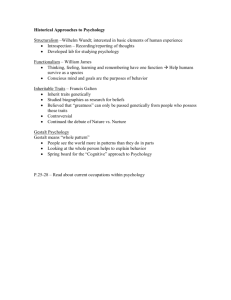Lecture2
advertisement
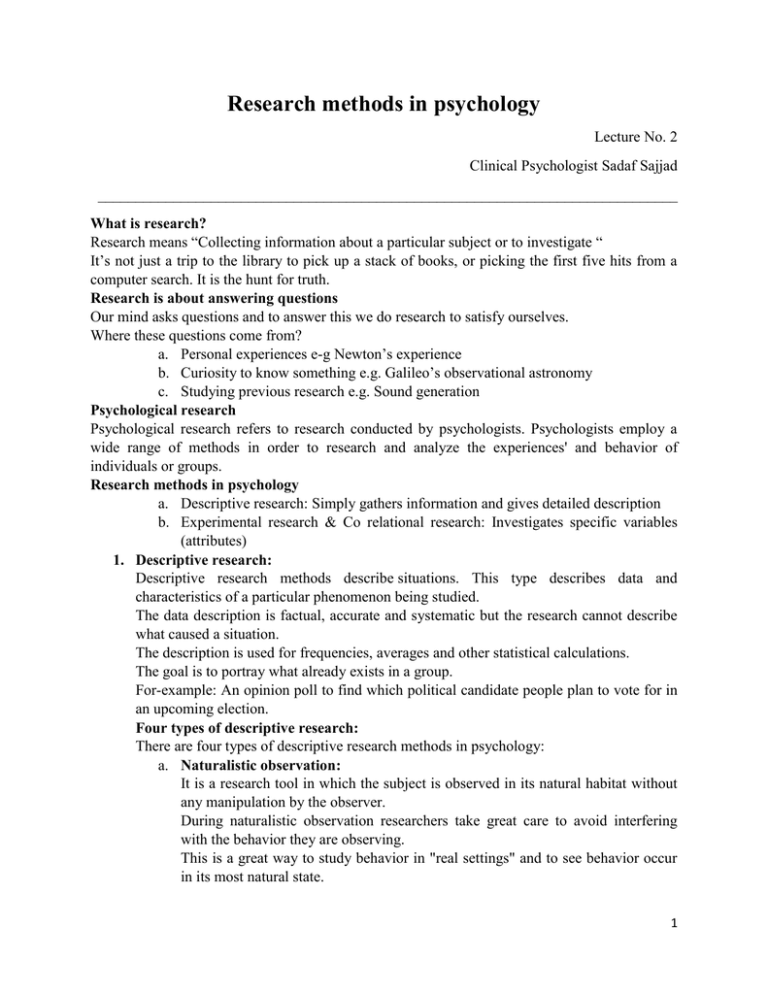
Research methods in psychology Lecture No. 2 Clinical Psychologist Sadaf Sajjad _____________________________________________________________________________ What is research? Research means “Collecting information about a particular subject or to investigate “ It’s not just a trip to the library to pick up a stack of books, or picking the first five hits from a computer search. It is the hunt for truth. Research is about answering questions Our mind asks questions and to answer this we do research to satisfy ourselves. Where these questions come from? a. Personal experiences e-g Newton’s experience b. Curiosity to know something e.g. Galileo’s observational astronomy c. Studying previous research e.g. Sound generation Psychological research Psychological research refers to research conducted by psychologists. Psychologists employ a wide range of methods in order to research and analyze the experiences' and behavior of individuals or groups. Research methods in psychology a. Descriptive research: Simply gathers information and gives detailed description b. Experimental research & Co relational research: Investigates specific variables (attributes) 1. Descriptive research: Descriptive research methods describe situations. This type describes data and characteristics of a particular phenomenon being studied. The data description is factual, accurate and systematic but the research cannot describe what caused a situation. The description is used for frequencies, averages and other statistical calculations. The goal is to portray what already exists in a group. For-example: An opinion poll to find which political candidate people plan to vote for in an upcoming election. Four types of descriptive research: There are four types of descriptive research methods in psychology: a. Naturalistic observation: It is a research tool in which the subject is observed in its natural habitat without any manipulation by the observer. During naturalistic observation researchers take great care to avoid interfering with the behavior they are observing. This is a great way to study behavior in "real settings" and to see behavior occur in its most natural state. 1 Advantages: 1. Realistic view of how behavior occurs 2. Observer effect Disadvantages: 1. Observer bias 2. Each naturalistic setting is unique b. Laboratory observation: It is a research tool that includes observing the individual in a laboratory setting, paying close attention to his/her reaction or behavior, which is not as good as observing them in their natural environment. This method allows more “control” than that of a naturalistic observation but limits reality. Advantages: The researcher has some degree of control i-e manageable Disadvantages: 1. Artificial setting may result in artificial behavior 2. Biased and not conclusive as to cause and effect 3. Observer has the option of being non-participant and the study itself may be structured c. Case studies: Case studies are in-depth investigation of a single person, group, event or community. The information is gathered by interacting with the information source involving observation, conversation or psychological testing to provide a description of behavior. It involves simply observing what happens to, or reconstructing “the case history” of a single participant or group of individuals. Advantages: 1. Amount of detail it provides 2. The only way to get certain kind of information 3. Study things that are rare Disadvantages: 1. Observer bias 2. Don't know if the cases studied generalize to larger population 3. May not be representative of condition, event; subject to misinterpretation by experimenter d. Surveys and interview: Interview: Interview is a conversation with a purpose. The interviewer in one-to-one conversation collects detailed personal information from individuals using oral questions. 1. Usually face to face 2 2. Can use different types of questions, from highly structured (surveys) to unstructured, participant-led (e.g. therapy sessions) 3. Most are semi-structured, i.e. some questions are prepared in advance, but these are flexible and can be adapted to follow areas of interest Survey: Survey is a research tool that uses interviews and/or questionnaires to gather information about aptitudes, beliefs, experiences or behaviors of a large group. A survey may focus on factual information about individuals, or it might aim to collect the “opinions” of the survey takers. In this method the research extracts a sample (representative/small group) out of a population to conduct a survey because too large population cannot be studied. 1. Population of the study: The entire group of interest to researcher and to which they wish to generalize findings; a group from which a sample is chosen. 2. Sample of the study: The portion of the population selected for study and from which generalizations are made about the population. Advantages: 1. Private information 2. Amount of data from large group of people Disadvantages: 1. Representative sample out of a population 2. Courtesy bias 3. Misremember things 4. Distort truth 2. Experimental research: An experiment is a study of cause and effect. It differs from non-experimental methods in that it involves the deliberate manipulation of one variable, while trying to keep all other variables constant. What is a variable actually? A variable is something that can be changed, such as a characteristic or value. Variables are generally used in psychology experiments to determine if changes to one thing result in changes to another. Types of variables in experimental method: 1. Independent variable: It is the input variable that is controlled and manipulated by the experimenter to cause change in dependent variable. 2. Dependent variable: It is the output variable that is measured by the experimenter. It tells about the effect produced by independent variable on it. Experimental group: In an experiment, there is a group of participants that is exposed to the independent variable or treatment to find the output variable. For-example 3 We want to investigate which method is more successful at teaching children to read. The teaching method is the independent variable. The children's reading ability depends on the teaching method used that is the dependent variable. Advantages: 1. Experiments are the only means by which cause and effect can be established. 2. It allows for precise control of variables. 3. Experiments can be replicated Disadvantages: 1. Experimenter effect 2. Artificiality 3. Known response from the participant 3. Correlational research: A Research tool that finds a relationship between two variables that are to be studied. It gives an indication of how one variable may predict another. It finds the ”strength of relationship” between two variables. For-example: Self esteem Vs Loneliness Are you lonely because you have a low self-esteem? OR You have low self-esteem because you are alone? Three types of correlational research methods There are three types of correlational research methods in psychology: a. Positive correlation: In this correlation the amount of one variable increases and the other decreases. For-example: More studying hours causes More Grade Point Average (GPA) Less studying hours causes Less Grade Point Average (GPA) b. Negative correlation: In this correlation the amount of one variable increases and the other decreases. For-example: More playing hours causes Less Grade Point Average (GPA) Less playing hours causes More Grade Point Average (GPA) c. No correlation: In this correlation indicates no relationship between the two variables. For-example: Size of video game player has no effect on Grade Point Average (GPA) Advantages: 1. Calculating the strength of a relationship. 2. Useful as a pointer for further, more detailed research i-e “Predictor” Disadvantages: 4 1. Cannot assume cause and effect, strong correlation between variables may be misleading. 2. Lack of correlation may not mean there is no relationship, it could be non-linear. History of psychology Life before psychology- René Descartes (1596-1650): Philosophy asks questions about the mind: 1. Does perception accurately reflect reality? 2. How is sensation turned into perception? Problem - No “scientific” way of studying problems Psychology is born - Wilhelm Wundt (1832-1920): First Experimental Psych Lab (1879) Focuses on the scientific study of the mind. It was focused that Psych methods were as rigorous as the methods of chemistry & physics. The beginning - Physiologist & Perceptual Psychologist Founder of Psychology as a Science Behaviorism - John Watson (1878-1958): Scientific Psychology should focus on observable behavior. He argued that Mental Processes cannot be studied directly. Observation- Founder of Behaviorism Understanding mental processes - Edward Titchner (1867-1927): Student of Wilhelm Wundt Focused on mental processes and analyzed the intensity, clarity and quality of parts of consciousness. He did “Introspection” i-e the examination of his own conscious thoughts and feelings to observe mental state. Introspection- Founder of structuralism Structuralism: 5 Structuralism defines the question of what each element of the mind is. He concluded from his research that there were three types of mental elements constituting conscious experience: 1. Sensations (elements of perceptions) 2. Images (elements of ideas) 3. Affections (elements of emotions) These elements could be broken down into their respective properties, which he determined were quality, intensity, duration, clearness, and extensity. Hence, 1. He studied the basic elements of thoughts and sensations 2. Focused on basic sensory and perceptual processes 3. Measured reaction times Understanding FUNCTIONALITY - William James (1842-1910): Investigated the function, or purpose of consciousness rather than its structure called “Functionalism”. Leaned applied work (natural surroundings) Psychology is the study of mental activity (e.g. perception, memory, imagination, feeling, judgment). Mental activity is to be evaluated in terms of how it serves the organism in adapting to its environment. Purpose of consciousness- Founder of Functionalism Difference between structuralism and functionalism 1. Structuralism: Basic parts of a person’s thoughts and feelings. Focus on basic senses & perception. 2. Functionalism: How our consciousness helps us to function or adapt to our environment. Gestalt psychology: “The whole is different than the sum of its parts.” Gestalt means "organized whole". It means that the eye merely takes in all the visual stimuli and the brain arranges the sensations into a coherent image. It states that whatever we see is in the form of groups as we do not look at each individual part of the image. For-example: Describing a tree - it's parts are trunk, branches, leaves, perhaps blossoms or fruit. 6 But when you look at an entire tree, you are not conscious of the parts, you are aware of the overall object - the tree. Psychoanalytical perspective - Sigmund Freud (1856-1939): Believed that abnormal behavior originated from unconscious drives and conflicts. Thoughts, memories & desires exist below conscious awareness and exert an influence on our behavior. Unconsciousness- Founder of Psychoanalytical perspective Psychoanalytic Theory attempts to explain personality, mental disorders & motivation in terms of unconscious determinants of behavior. Cognitive Psychology: “The mental processes involved in acquiring, processing, storing & using information” It is the study of how people perceive, remember, think, speak, and solve problems. It explicitly acknowledges the existence of internal mental states (such as belief, desire, idea, knowledge and motivation). Sociocultural Psychology: Examines how cultural and political (religious) experience affects our everyday life. 1. It studies how norms and social influences affect behavior. 2. Ambition/Goals/Values: Environments influence on one’s long-term ambitions. 7
